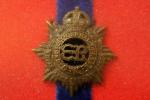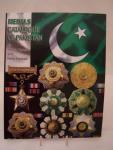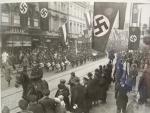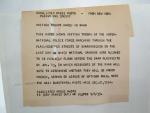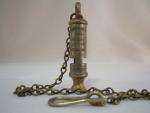-
Posts
6,486 -
Joined
-
Last visited
-
Days Won
10
Content Type
Profiles
Forums
Blogs
Gallery
Events
Store
Everything posted by Brian Wolfe
-

Matt Tiller Becomes a Parish Constable
Brian Wolfe commented on Mervyn Mitton's blog entry in Mervyn Mitton's Blog
What a great idea and I look forward to following the story as it unfolds. Regards Brian -
Collecting the Periphery Part One Most of what we see here on the GMIC and on other military focused forums is mainstream and by that I am referring to the collecting of medals. Medals for campaigns, long service, good conduct and “been there and got the T shirt” fill online auction pages and the catalogues of dealers around the world. Interestingly there are many areas of civilian medals that seem to have gone unnoticed by the collecting world in general. Police medals and equipment will not be included in this essay simply because I would like to concentrate on medals not dealing with keeping the peace which would, of course, include both the military and police. The first of these non-military or police medals that comes to mind is the multitude of Red Cross medals that are available to the collector. The Red Cross, founded by Henry Dunant in 1863 in Geneva Switzerland, has been on hand to give care and comfort in all the wars since its founding as well as providing relief during times of natural disasters and carrying out first aid training to the civilian population. The collecting of Red Cross memorabilia is perhaps not as far from main-stream as I would like to take today’s discussion. I say this as not only is the Red Cross, Red Crescent, St. John’s Ambulance among others, on hand during armed conflicts but, in the case of the Red Cross, there were WWII medals, the British War Medal and Victory medals named to members of the Red Cross. An example of this from my own collection is the BWM and Victory pair named to, J. (Jeanie) Low, B.R.C.S. and a group which in includes a St. John Ambulance Brigade Medal named to Special Constable Sgt. W. (William) C. Holley, Hants (Hampshire County) S.J.A.B. 1953. Sgt. Holley served with the S.J.A.B. from 1940 to 1961. His group also includes the British Defence Medal and Special Constabulary Long Service and Good Conduct Medal. Another example from my collection is a Red Cross Medal for Proficiency in Anti-gas Training named to 6938 C. Barclay who served with the Red Cross from 1938 to 1968. There is little doubt that the anti-gas training was connected with the Second World War threat of gas attack from Germany. Perhaps one of the best examples of the close ties between the military and the Red Cross may be found in the study of post Shogunate (1868 onward) Japanese Medals. The following is a quote from “In the Name of a Living God” by Paul L. Murphy and Steven L. Ackley. If you don’t have this book and have any interest in non-government badges and medals of Imperial Japan I highly recommend you purchase one. You WILL NOT regret it. “The forerunner of the Japanese Red Cross Society was the Hakuaisha (Philanthropic Society) which was founded in 1877 by Count Tsunetami Sano to help those who were wounded in the Satsuma Rebellion earlier that year. Japan signed the Geneva Convention in 1886 and in the following year the Hakuaisha changed its name to the Japanese Red Cross Society (Nippon Sekijujisha). It was recognized as such by the International Committee of the Red Cross on September 2, 1887. The society is under the patronage of the Imperial family and the symbol of the society is taken from the hair pin of the Meiji Empress that featured a Pawlonia, bamboo and ho-o bird. This design and/or the Geneva cross features on all of the badges and medals of the society”. Membership in the Nippon Sekijujisha was very common among military personnel so much so that many photos and medal groups may be found with the Red Cross Society’s medal included. In my own collection I have a photo of a soldier wearing the 1894-1895 War Medal (Sino-Japanese War) alongside the Nippon Sekijujisha Men’s Life Membership Medal. Another example, again from my own collection, is a four place ribbon bar with the Order of the Rising Sun (Kyuokujitsusho), Manchurian Incident (1931-1934), China Incident (1937 – 1945) along with the ever present Red Cross Medal ribbon. While doing research for this article I saw a group of Japanese medals and the description was of all of the military medals followed by “...and the Red Cross medal, of course”, demonstrating just how common it is to find the Red Cross Medal associated with the Japanese Military. I apologize that I cannot give proper credit for the quote above as I did not write down the source and my memory fails me on this point. If it was one of our fellow GMIC members please accept my sincere apologies. Please watch for Collecting the Periphery Part 2 coming soon where we will travel further afield away from mainstream collecting. Sources: Wikipedia – International Red Cross and Red Crescent Movement Orders and Medals of Japan and Associate States – James W. Peterson In the Name of a Living God – Paul L. Murphy & Steven L. Ackley Reference to specimens – Author’s collection
-
Hi Larry, I would be interested in seeing the group. From the looks of your photos I'd say it was genuine so whether the medal "doubled up" is to regs. or not matters little (IMO) as it was no doubt done at the request of the soldier. Regards Brian
-
A known expert on South Asian medals claims that when two medals are awarded that are the same that according to regulations only one is to be worn. However, this is not the first time I've seen two of the same medal mounted up in a group. The expert I am referring to has also said that anything can happen and it will, at least twice in India (Pakistan in this case). It is my feeling that even though the regulations may say one thing veterans could have just about anything mounted up and who would say anything? I know of one Canadian (I'm sure there were others) who added a medal to his group as he felt he had earned it yet due to one thing or another his service fell through the cracks in the reulations. As to the clasp with the "missing" claws, I would say that this was the only way they were issued. Let's go with that and stop looking for one. That way when I find one I can show it off here and be ever so smug about being the only one with one in his collection. Seriously, even though it would seem to be the way they were issued lets keep looking and get one posted here on the forum, I really want one. Good hunting. Regards Brian
-
Hello Paul, This is indeed an interesting artifact, thanks for posting it, otherwise we would not likely ever see one. Regards Brian
-

KING EDWARD VIII COINS / MEDALLIONS
Brian Wolfe replied to QSAMIKE's topic in Coins & Commemorative Medallions
This is not a medal but it is military. It a collar badge from my collection and I hope you can see this clearly, it is Edward VIII. Regards Brian -
The Tamgha-i-Khidmat, Classes I, II and III are awarded only to Junior Commissioned Officers, for rendering long, meritirious or (note "or") distinguished service of a non-operational nature. [Medals Catalogue of Pakistan, Yahya Qureshi and Rafiq Kasbati, page 31] Regards Brian
-
Hello Owain, Thanks for that additional information. Ed no longer visits us here at GMIC so a response from him is unfortunately unlikely. Regards Brian
-

KING EDWARD VIII COINS / MEDALLIONS
Brian Wolfe replied to QSAMIKE's topic in Coins & Commemorative Medallions
These are quite interesting and the first I've seen. I'm glad Paul was able to respond with his information before I logged on today as now we have that information and I'm not left wondering all day as to their history. I think these are examples of "what might have been". There are the white metal coronation medals that were given out to the public and the only one I attempted to purchase was "lost" in the mail. Thanks for posting these, they are great to see. Regards Brian -
Option A or Option B What you are about to read you may find disturbing or even offensive. If you do then you need to grow up. The permanency of life is an illusion and you cannot afford to delude yourself to thinking you are immortal. Therefore, if you have elected to read on, you have been duly warned and I will make no apologies if you find your delicate feelings have been hurt. Jim [not his real name] was 6 foot 2 inches tall, a big guy but not such as you would say was overweight at all. Age had left him, as it does most of us, a little soft in the midsection. This was just about all that was soft about Jim. He had the weathered look of someone who had worked hard out in the elements; a grizzled beard peppered with gray and a gruff personality pretty well summed up what Jim looked like. To most of the office staff he was a scary fellow best avoided and this had not changed since he became Zone Officer and was now stationed in head office. Others, like me, who have been seasoned by years of working in the field recognized a kindred spirit and fully appreciated his dark sense of humour. Jim had been with the Authority for 31 years and had become part of the corporate landscape. Late in 2011, after feeling unwell for a period of time, he made a rare appointment with his doctor. At 59 years of age he was told, after a battery of tests that he had prostate cancer, and worse it had spread to his bones and was now throughout his body. Jim knew his chances were extremely slim to none, with “none” being the odds on favour. He also knew what lay ahead of him with the proposed radiation and chemotherapy followed by what would most likely be a long agonizing death filled with unimaginable pain and suffering, held at bay for a while with massive amounts of drugs. In the end he knew he would be in a vegetative state out of touched with the world and loved ones only to finally die in a haze of confusion and pain. He was aware that his family and friends would be put through their own form of suffering as he slowly wasted away. It was time for Jim to weight his options. Option A: To go through the torture and suffering ahead knowing full well that death awaited him in the end, or Option B. Early this week Jim made his choice and took his own life. I cannot judge Jim’s choice of Option B, even though I have fought and won two battles against cancer, as I have never stood at the threshold of the great unknown and had to make that fateful decision. I only wish he had chosen to have had a simple prostate examination a few years ago. If he had I would not likely be writing this missive today. Rest in Peace old buddy. Now, my friend, it is your time to make a decision. If you have not already done so, make an appointment with your doctor and set up a prostate exam. Otherwise you may have to make the choice of, Option A or....Option B. Respectfully Brian
- 13 comments
-
10
-
Hello Mervyn, I muist have been absent from school the day they covered that subject. Thanks for the information and I shall make that note with the first photo of each post. Regards Brian
-
Well, the photo didn't reproduce as large as it should have. The book, Medals Catalogue of Pakistan The authors are, Yahya Qureshi and Rafiq Kasbati and they are the publishers. Regards Brian
-
Hi Steve, Thanks, it is one of my favourite groups in my the Pakistan collection. I think the book you mentioned could be the one pictured below. I doesn't go into a lot of detail but considering the lack of good books on the subject on the market today this is worth having. Regards Brian
-
I can only echo Steve's comment. As yet I have not seen any example except for the soldered attachment. Even the resource material I have mentions nothing about a claw attachment. I guess until an example surfaces we'll have to assume that the soldered version is indeed the official issue. Regards Brian
-
Hello Steve, When the Tamgha-i-Khidmat arrives please be sure to post it. I am surprised that it went for £15, I think that is a pretty good buy. Well done. Regards Brian
-
Stunning it is, thanks for posting this. Regards Brian
-

The Perfect Sick Day
Brian Wolfe commented on Brian Wolfe's blog entry in News From the Home Office.
Mervyn, I'm not sure you should trust those you represent, after all they do wear masks. Brian -
Welcome to the forum Steve, good to see another SC collector on board. Also welcome to my personal collecting Hades (you can't say H-E-double hockey sticks in polite company). Trying to research these medals especially, as Alan pointed out, without the box is just about impossible. I hope to hear more form you as time passes. Regards Brian
-
Hello Mervyn, As you can imagine I was torn between this section and the Police section. From what I understand these were military on a policing duty so I felt this was the correct section. Using the military makes sense considering all of the factions that were in the area which might have resulted in the need for more force than would be expected from a police officer. As a side note, I'm sorry about the small size of the letters. I wrote this in a word document and then imported it into the post. This lets me work on a piece over several days, otherwise I never get the time to finish a post in good time. I'll try to fix this problem for the next such post, perhaps using a larger size lettering on this end. It's funny because the blog section works just fine doing it the way I did for this post. I guess everyone knows the Alt+ or - trick. Regards Brian
-
International Police Force, Saar 1934 This photo arrived the other day and I purchased it because I think it shows a very significant period in history. More than that I believe it captures an event that is about to take place that was one of the first of the “dominos” to fall that led up to the Second World War. As the note on the back of the photo states (see image below) these are the British Troops of the International Police Force marching through the streets of Saarbrücken on the last day before the plebiscite that would restore the territory of the Saar Basin to Germany. A movement to establish an International Police Force was started in the 1930s with the idea that this force would enforce the peace. One of the main supporters for this initiative was Lord David Davies and he outlined his own version in his book, The Problem of the Twentieth Century (1930). His work influenced British planners to support some sort of international policing in keeping with the intentions of the League of Nations, the forerunner of the United Nations. The Saar Basin, a region of German, was occupied and governed by the United Kingdom and France after the First World War under a League of Nations mandate. Originally this was under the auspices of the Treaty of Versailles. The occupation of this highly industrialized Saarland was to be for a period of fifteen years. During this occupation the coal reserves of the area were controlled by France, possibly as a condition imposed upon German in an effort to pay for the cost of the war. Once this fifteen year occupation was ended there was to be a plebiscite to determine the Saar’s future. In Germany, at this time, the Nazi Party, under Adolf Hitler, was gaining power. Contrary to what one might take from news films of the time, shown in documentaries today, not everyone was a supporter of this regime. Many opponents fled Germany and a considerable number of them settled in the Saar Region. Naturally as the plebiscite date drew closer the opponents of the Saar returning to German control openly supported remaining with British and French occupation under the League of Nations mandate. On 13 January 1935 the plebiscite was held and the region returned to Germany and the control of the Nazis. The vast number of the population being German made the occupation and therefore control by the British and no doubt especially the French very unpopular. During the actual time of the plebiscite there was a fear of Bolshevism, this plus the support of the local Catholic authorities and a general dislike of the occupation sealed the fate of the Saar. On 17 January 1935 the Saar was returned to Germany approved by a motion of the League of Nations and on 1 March the Saar was officially absorbed into the German Reich. Former politicians, collaborators of the occupation and opponents of the Nazi Party in the Saar were all arrested and imprisoned, once Hitler had control of the region. Following this act Adolf Hitler announced to the world that Germany had no further territorial demands to make of France. Today we know that this was only the beginning of territorial demands, which were to be followed by statements from Hitler that Germany “had no further demands”, until the outbreak of the Second World War in 1939. Regards Brian Research material for this article from: Wikipedia, Saar (League of Nations) The International Encyclopaedia of Political Science: Policing the World, Lord Davies and the Quest for Order in the 1930’s.
-
As per your request Mervyn, here is a Bucks Special Constabulary whistle. Not that I have been collecting these for decades and we don't see a lot of British Special Constabulary material in Canada, however, this is the first one I have seen offered for sale. It just arrived and I wanted to post it even though it is in need of a clean. Regards Brian
-
The Perfect “Sick Day” Don’t you really dislike those dedicated types who will come to work sick? After all, who needs to pick up whatever “bug” they have just because they lack the common decency to stay home. Well, I am one of those miserable sods. In all fairness, this time of the year, I have almost no human contact as my days are spent outside “in the field” (as we say). So unless I pass this cold on to a raccoon or deer no one suffers but me. Friday morning rolled around and I take the afternoon off on that day in lieu of payment for being on call 24/7, 365 days a year. So a cold was not about to keep me home for the morning, the night before we had experienced an ice storm and the roads were a sheet of ice. Still this didn’t deter my intentions to go to work. My wife hates riding in a vehicle when I am driving on weekends, when I am not at work of course. She says that I am not as good a driver as I think I am. I always agree with her but come back with my theory that I may not be the most skilful driver on the road but I have a great deal of luck, I follow this up with a quote from Star Wars, “Trust in the Force, Luke”. She is never impressed, as we careen our way down the highway. Here’s my reasoning. I’d rather be a lucky driver than a skilful one. Why? You never say, “Lucky bastard, he was killed on the highway”. You might say, ‘I can’t believe old Fred was killed in an accident, he was such a good driver”. I rest my case. It was at this time the radio announced that there were several severe accidents on the highways between here and the office. While I think I am Lady Luck’s favourite child there are times when you get the feeling she may have gone to the shopping mall leaving you on your own. Even though this was the first time in five years that I didn’t go to work I was not particularly disappointed as I had a whole day to play in the shop (Truncheon Competition project) and surfing the net, especially here on GMIC. I had intended to contact one of our members on Skype but this cold causes me to go into coughing fits whenever I try to talk for any length of time. It’s Sunday morning and my dear wife says she is still enjoying the peace and quiet. Women can be so cruel. After half a dozen coffees and with the new abilities to be able to thread a sewing machine while it is running, thanks to the infusion of copious amounts of caffeine, I headed to the work shop and the truncheon project and the start of the perfect sick day. Please include cash in any “get well” cards. Ha ha Regards Brian



